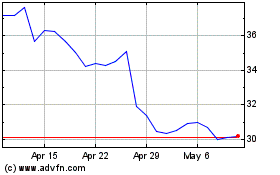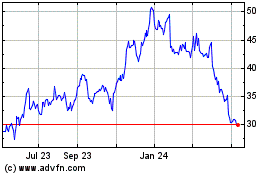Intel Sees Opportunity in U.S.-China Tensions' Impact on Supply Chains
October 20 2020 - 2:12PM
Dow Jones News
By Asa Fitch
Intel Corp. could see new business opportunities from a
bifurcation of tech supply chains amid growing tensions between the
U.S. and China, the chip maker's Chief Executive Bob Swan said.
The U.S. and several other countries have limited or blocked
Chinese telecom giant Huawei Technologies Co. from providing
equipment for their 5G infrastructure over concerns about security
and potential espionage -- claims Huawei denies. Those constraints
leave gaps that others -- including Intel -- could fill by
providing the chips that power the superfast networks.
But Intel also illustrates how the intensifying battle between
Washington and Beijing over tech dominance brings both risk and
opportunity. The company is still a major supplier to customers in
China, where its chips are used in personal computers, servers and
a range of other devices.
"China is a big market for us, but at the same time Intel
playing a broader role in 5G infrastructure is also an opportunity
for us," Mr. Swan said at the WSJ Tech Live conference, which was
held remotely on Tuesday. Overall, he said, the company and the
industry would benefit from free global trade.
Intel agreed Monday to sell its flash-memory manufacturing
business to South Korea's SK Hynix Inc. for $9 billion. That
business has operations in Dalian, China, Intel's only major
chip-making facilities in the country.
Mr. Swan said Intel was selling the business to unlock capital
to use on better opportunities in fast-growing areas such as 5G and
artificial-intelligence computing.
Mr. Swan, who has been in the top job at Santa Clara,
Calif.-based Intel around two years has presided over the company
during an especially challenging period during its more than
50-year history. He inherited problems with making the smallest and
most-cutting edge chips, which have persisted. Rival chip maker
Nvidia Corp. has now surpassed Intel by market value.
The Intel CEO said Tuesday that he is trying to shift the
Silicon Valley icon from being known mainly as the leading provider
of central processing units, which go into personal computers and
servers, toward a broader set of activities. Intel historically has
had a commanding share of around 90% in central processors, but Mr.
Swan said the metric he is more focused on is holding a 30% share
in a much larger market for all kinds of chips.
Write to Asa Fitch at asa.fitch@wsj.com
(END) Dow Jones Newswires
October 20, 2020 13:57 ET (17:57 GMT)
Copyright (c) 2020 Dow Jones & Company, Inc.
Intel (NASDAQ:INTC)
Historical Stock Chart
From Mar 2024 to Apr 2024

Intel (NASDAQ:INTC)
Historical Stock Chart
From Apr 2023 to Apr 2024
